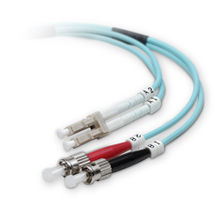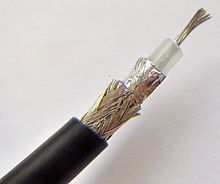Networking cable
Networking cable is a piece of
While
There are several technologies used for network connections.
Twisted pair

Twisted pair cabling is a form of wiring in which pairs of wires (the forward and return conductors of a single circuit) are twisted together for the purposes of canceling out electromagnetic interference (EMI) from other wire pairs and from external sources. This type of cable is used for home and corporate Ethernet networks. Twisted pair cabling is used in short patch cables and in the longer runs in structured cabling.
There are two types of twisted pair cables: shielded and unshielded.
Ethernet crossover cable
An
Fiber optic cable

An
Coaxial cable

Coaxial cables form a transmission line and confine the electromagnetic wave to an area inside the cable between the center conductor and the shield. The transmission of energy in the line occurs totally through the dielectric inside the cable between the conductors. Coaxial lines can therefore be bent and twisted (subject to limits) without negative effects, and they can be strapped to conductive supports without inducing unwanted currents in them.
Early Ethernet, 10BASE5 and 10BASE2, used baseband signaling over coaxial cables.
The most common use for coaxial cables is for television and other signals with bandwidth of multiple megahertz. Although in most homes coaxial cables have been installed for transmission of
Patch cable
A
Power lines
Although power wires are not designed for networking applications,
See also
- ISO/IEC 11801, general-purpose telecommunication cabling
- Telecommunication cable
References
- ^ "Network Cables". Networktutorials.info. Archived from the original on 2010-12-24. Retrieved 2012-10-16.
{{cite web}}: CS1 maint: unfit URL (link) - ^ a b "Ethernet Cable Identification". Donutey.com. Archived from the original on 2016-03-06.
- ^ "Data Cabling - Total Solution Computing". Retrieved 2017-04-30.[permanent dead link]
- ^ "New global standard for fully networked home" (Press release). International Telecommunication Union. 2008-12-12. Archived from the original on 2015-03-13. Retrieved 2018-02-16.
